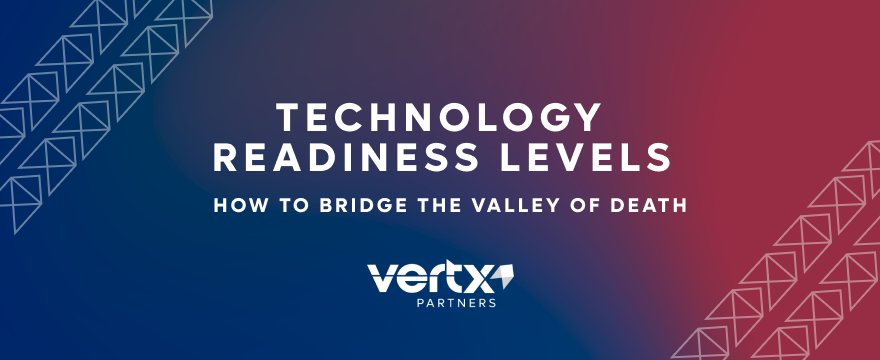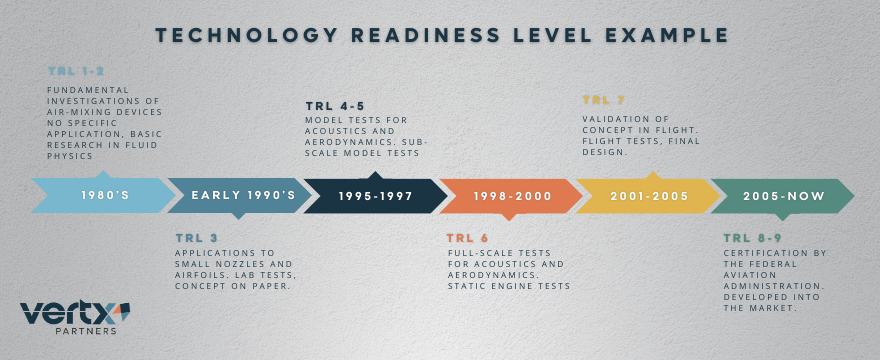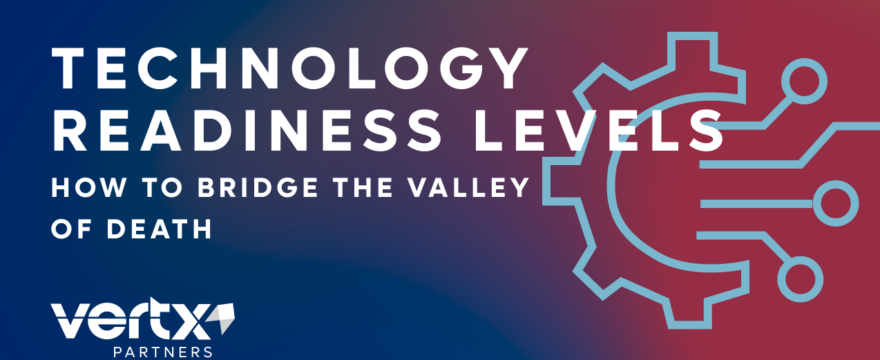In this guide, we talk about the nine Technology Readiness Levels and how to bridge the treacherous Valley of Death.

Why should you care about Technology Readiness Levels?
Developing new technology is difficult, and there are many steps that a product has to take before it can be put on the market. Without a proper assessment of your technology, you have the possibility of pushing it when it isn’t ready. So, what happens when a technology isn’t ready and is pushed through as it is? It fails.
However, you can avoid that with Technology Readiness Levels (TRLs).
NASA created what we call the Technology Readiness Levels. The TRLs are a scale consisting of nine levels used to assess what maturity your specific technology is at. This allows personnel to understand how much development a certain technology needs before becoming utilized. It also helps you address any risks your technology may have while allowing you to witness its evolution. When creating a technology specifically for government organizations, this is a much-needed tool. It allows you to continue your research and to test toward succession.
WHAT ARE TRLs AND WHAT DO THEY DO?
Assessors use Technology Readiness Levels as a type of measurement system to assess the maturity level of critical technology. When developing a new or novel technology, it is important that you assess and track the development. Every technology starts with an idea and continues to grow over the years until innovators develop it into an actual system. Assessors use TRLs to determine the risks, assess how much funding and research is necessary, and determine if your technology should continue through its process. This gives you and your personnel a better idea of where you are at.
WHO USES TRL RATINGS, AND HOW DO YOU GET ONE?
Originally created by NASA, the U.S. Department of Defense (DoD), Department of Energy (DoE), Air Force, Oil and Gas Industry, Academia, and the European Space Agency (ESA) have adopted the TRL scale and Technology Readiness Assessments (TRA). These agencies use TRLs and TRAs to help manage their acquisitions. When working with these agencies, they will give you a rating once your technology validates the description in the diagram. But how do you move up ratings?
Let’s say you are working with NASA and have an idea that will improve fuel technology. You would assign the new idea a TRL rating of 1. To be able to move to TRL rating 2, you must be able to validate the components of your idea. Your technology will remain at TRL 1 until the validation process is complete.
Universities, along with government funding sources, tend to focus on TRL ratings 1 through 4, and private sectors focus on TRL ratings 7 through 9. Later in the guide, we will talk about what happens if you fall between ratings 4 and 7.
EACH TRL AND ITS MEANING
The scale consists of nine levels, each one requiring the innovator to demonstrate the technology. TRL maturity goes from 1 through 9, with 1 being the lowest maturity and 9 being the highest. Your technology will go through each level until the final level, where the actual operation of the technology is in its final form and proven successful.
Level 1:
Basic principles observed and reported. The lowest level of technology readiness, here, basic scientific research that can be turned into an application or a concept under a research and development program.
Level 2:
Technology concept and/or application formulated. Invention begins. Once assessors observe basic principles, innovators can devise practical applications. Applications are speculative, and there may be no proof or detailed analysis to support assumptions.
Level 3:
Analytical and experimental critical function and/or characteristic proof-of-concept. Innovators initiate active research and development. This includes analytical studies and laboratory studies to physically validate analytical predictions of separate elements of the technology. This will provide a “proof of concept.”
Level 4:
Component and/or breadboard validation in a laboratory environment. Innovators build basic examples of the proposed technology for testing to offer an initial vote of confidence for continued development.
Level 5:
Component and/or breadboard validation in relevant environments. More realistic versions of the proposed technology are tested in real-world or near real-world conditions, which includes initial integration at some level with other operational systems.
Level 6:
System/subsystem model or prototype demonstration in a relevant environment (ground or space.) A near-final version of the technology in which additional design changes are likely is tested in real-life conditions. This represents a major step up in a technology’s demonstrated readiness.
Level 7:
System prototype demonstration in a relevant environment. The final prototype of the technology that is as close to the operational version as possible at this stage is tested in real-life conditions.
Level 8:
Actual system completed and “flight qualified” through test and demonstration (ground or space.) The technology is thoroughly tested, and no further major development of the technology is required. Its operation as intended is demonstrated without significant design problems. In almost all cases, this TRL represents the end of system development.
Level 9:
Actual system “flight proven” through successful mission operations. The final operational version of the technology is thoroughly demonstrated through normal operations, with only minor problems needing to be fixed. Any further improvements to the technology at this point, whether planned or not, will be treated as a TRL 1.
Let’s give a real-life example of how a new innovation has been developed:
NASA’s quest to make jet engines quieter led them to develop chevrons, which moved relatively quickly through the Technology Readiness Level process. It wasn’t long before engineers adopted them in their engine designs. Here is what happened with the development at each level:

WHAT IS THE VALLEY OF DEATH?
Earlier, we talked about how universities focus on TRLs 1 through 4, and private sectors focus on 7 through 9, but what happens if you fall between 4 and 7? Assessors refer to this as The Valley of Death. This represents the often-neglected TRLs 4 through 7. At this stage, you’re trying to move from research to the market. This is where neither universities nor private sectors prioritize investment. So, how do you bridge the Valley of Death?
You take measured steps. At this stage, it is important for you to analyze the problem. There are many barriers to the commercialization of technologies and research, including inadequate analysis of technology needs or market size and a lack of entrepreneurial management, funding, and incentives. The answer to getting out of the Valley of Death isn’t to cross the bridge but to pursue a stepladder. That’s why Vertx is here to help.
If you feel like the Valley of Death is approaching, we’re here to help you on your journey of continuing your new technology. Our goal at Vertx is to help you continue your journey as an innovator. Vertx tailors solutions to your needs. Additionally, we help companies find their solution before the problem even happens. We take a creative and innovative approach to helping you continue your journey. Finally, Vertx offers a team of experienced professionals dedicated to helping you thrive free of charge.
HOW TO GET STARTED:
By now, understanding the importance of Technology Readiness Levels has hopefully been impressed upon you. For many first-timers, understanding TRLs can be confusing, especially how to overcome each level. Reach out today to start or continue your journey in the world of federal contracting.
Become an Innovator With Us
Tell us about yourself, answer a few questions, and hit submit. It’s as easy as that to get started.
